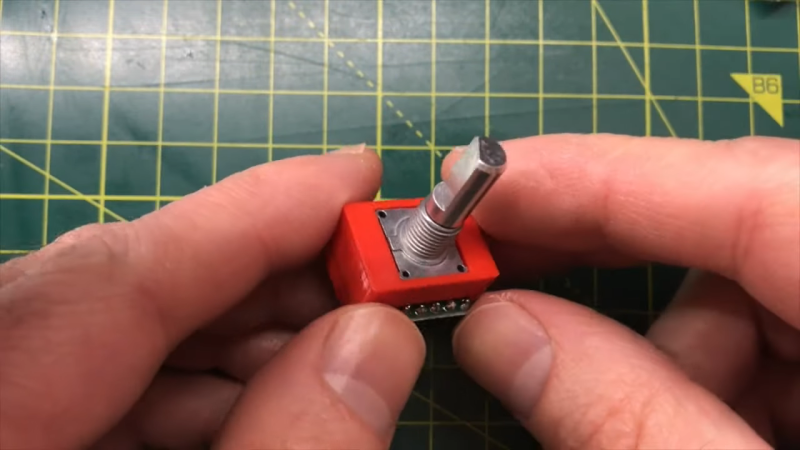Most of the hacks we see around these parts have to do with taking existing components and cobbling them together in interesting new ways. It’s less often that we see existing components gutted and repurposed, but when it happens, like with this reimagined rotary encoder, it certainly grabs our attention.
You may recall [Chris G] from his recent laser-based Asteroids game. If not you should really check it out — the build was pretty sweet. One small problem with the build was in the controls, where the off-the-shelf rotary encoder he was using didn’t have nearly enough resolution for the job. Rather than choosing a commodity replacement part, [Chris] rolled his own from the mechanical parts of the original encoder, like the shaft and panel bushing, and an AS5048A sensor board. The magnetic angle sensor has 14 bits of resolution, and with a small neodymium ring magnet glued to the bottom of the original shaft, the modified encoder offers far greater resolution than the original contact-based encoder.
The sensor breakout board is just the right size for this job; all that [Chris] needed to do to get the two pieces together was to 3D-print a small adapter. We have to admit that when we first saw this on Hackaday.io, we failed to see what the hack was — the modified part looks pretty much like a run-of-the-mill encoder. The video below shows the design and build process with a little precision rock blasting.















Why isn’t this a product?!
They already exist:
https://www.megatron.de/en/products/hall-effect-singleturn-rotary-encoder/magnetic-rotary-encoder-hall-effect-hsm22s.html
Not that this isn’t a cool hack.
Use what you’ve got.
A hsm22s is 160€+.
A AS5048A + magnet is about 17€.
Would you call them the same product, if someone in Shenzhen was pumping out enclosed AS5048A for 25€?
Yes, heaven forbid people designing products or buiding things not want to go to the trouble of sourcing a rotary encoder, peeling it apart, designing a 3d printed insert, designing and testing a circuit, then laying out the PCB, then getting it made, then sourcing the components, then assembling the PCB, then physically putting it all together.
Yeah, they’re totally suckers for paying more money than what a magnet an a single IC cost.
I actually bought an “enclosed product” from China for a project. Of course, the enclosed ones, for whatever reason seem to favor a 0-5 volt analog output, but it’s still a P3022 hall sensor. It’s just a nice unified package. I haven’t dug around to see if they are making the enclosed units with serial out versions or not, but the analog out is good enough for the ADC I’m using it with. The ones I used have the equivalent of 12-bits of accuracy, so not quite up to this one’s 14-bits. I honestly don’t know if that’s even resolvable in a hand controlled dial or not, but hey, whatever the project calls for, right!
Spent about $16 on the enclosed P3022 hall sensor I bought. Not to bad.
I’m well aware of the rotary encoders for drives that are well north of 100 bucks.
I meant exactly this usecase. They don’t exist
there are a lot of drop in hall angle sensors ready to go if you want to spend the money. like the $80 hall joystick module or the $120 hall potentiometer. a bare bones no frills hall sensor costs less than a buck and same for a suitable neodymium magnet. a 50x or higher markup is a lot to ask for applying maxwell’s equations. any hacker with a calculator and a 3d printer can make one. i see it as a clever way to stick it to the man.
Response time of the AS5048 ? Quick enough that you don’t miss twists ?
Datasheet says output sample rate is 11.25kHz with a system propagation delay of 100uS (10kHz), so long as you aren’t twisting it nearly that fast I’m sure it’d be fine for something as slow as a person twiddling a knob. The original application for these sensors is motor drive feedback sensing after all, orders of magnitude faster than something like a human interface would require.
Looks like the Curious Scientist also put out a video on this today:
AS5600 magnetic position encoder – best encoder for stepper motors
https://www.youtube.com/watch?v=yvrpIYc9Ll8
What a coincidence! Released the same day as the HaD post.